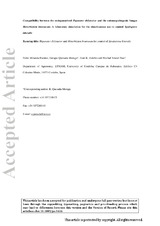Mostrar el registro sencillo del ítem
Compatibility between the endoparasitoid Hyposoter didymator and the entomopathogenic fungus Metarhizium brunneum: A laboratory simulation for the simultaneous use to control Spodoptera littoralis
| dc.contributor.author | Miranda-Fuentes, Pedro | |
| dc.contributor.author | Quesada-Moraga, Enrique | |
| dc.contributor.author | Aldebis, Hani K. | |
| dc.contributor.author | Yousef Naef, Meelad | |
| dc.date.accessioned | 2019-09-23T06:57:40Z | |
| dc.date.available | 2019-09-23T06:57:40Z | |
| dc.date.issued | 2019 | |
| dc.identifier.uri | http://hdl.handle.net/10396/18998 | |
| dc.description.abstract | BACKGROUND The cotton leafworm, Spodoptera littoralis, is one of the most destructive pests in the Mediterranean basin, being predominantly controlled using synthetic chemical pesticides. Strain EAMa 01/58‐Su of the fungus Metarhizium brunneum and the parasitoid Hyposoter didymator are promising biological control agents for this pest. In this study, we assessed the compatibility between these two agents to control S. littoralis under joint attack scenarios. RESULTS Firstly, the direct and indirect effects of the fungus towards parasitoid adults were studied. The fungus significantly decreased life expectancy of the parasitoid (mortality=62.5%; mean lethal concentration=1.85×106 conidia ml‐1; average survival time=92.2h) when applied at high concentrations (108 conidia ml‐1), whereas it did not affect the reproductive potential of the parasitoid females during the three days after treatment. Secondly, the combinations between the two agents to control S. littoralis under different simultaneous use scenarios (inoculation of S. littoralis larvae with the fungus before being exposed to parasitoid females and vice versa) were investigated, with additive effect in all cases. A significant effect on fitness (preimaginal development time and reproductive potential) of the F1 parasitoid generation were detected. Moreover, parasitization significantly reduced the total haemocytes in S. littoralis haemolymph compared with the control, promoting fungal infection. Finally, parasitoids showed a significant preference for non‐inoculated S. littoralis larvae. CONCLUSIONS We demonstrated compatibility (additive effect) between fungus and parasitoid under different joint attack scenarios to control S. littoralis in laboratory conditions. However, this will be supported by our ongoing greenhouse and field studies. | es_ES |
| dc.format.mimetype | application/pdf | es_ES |
| dc.language.iso | eng | es_ES |
| dc.publisher | Wiley | es_ES |
| dc.rights | https://creativecommons.org/licenses/by-nc-nd/4.0/ | es_ES |
| dc.source | Pest Management Science (2019) | es_ES |
| dc.subject | Integrated management | es_ES |
| dc.subject | Biological control | es_ES |
| dc.subject | Intra-host relationships | es_ES |
| dc.subject | Metarhizium brunneum | es_ES |
| dc.subject | Parasitoids | es_ES |
| dc.subject | Cotton leafworm | es_ES |
| dc.title | Compatibility between the endoparasitoid Hyposoter didymator and the entomopathogenic fungus Metarhizium brunneum: A laboratory simulation for the simultaneous use to control Spodoptera littoralis | es_ES |
| dc.type | info:eu-repo/semantics/article | es_ES |
| dc.relation.publisherversion | https://doi.org/10.1002/ps.5616 | es_ES |
| dc.relation.projectID | Gobierno de España. AGL2016-80483-R | es_ES |
| dc.relation.projectID | Gobierno de España. FPU16/03983 | es_ES |
| dc.rights.accessRights | info:eu-repo/semantics/openAccess | es_ES |

